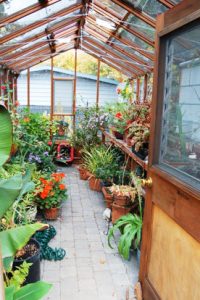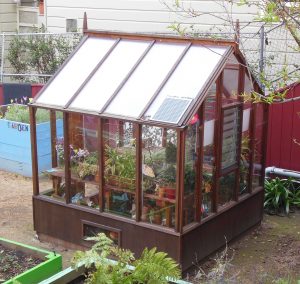 So you are thinking of building a greenhouse? Here are 5 basics to consider as you start the process.
So you are thinking of building a greenhouse? Here are 5 basics to consider as you start the process.
1. What environment do your plants need?
Are you starting seeds or over-wintering plants? This could be a basic greenhouse with benches and grow mats for heat. Growing tropical plants or hoping for tomatoes in the winter? You might need a more energy efficient structure, with lights and a heater. Growing orchids? In addition to heat and humidity, the greenhouse needs light diffusing glazing and possibly a structure that can support multiple hanging plants. Multiple uses planned? Fit the structure to the most demanding plants.
2. Where to put the greenhouse?
Location of the greenhouse should be convenient for you get to, especially in bad weather, but also fit with your landscape. It needs good sun exposure. A southeasterly exposure is best, with east, south and west exposures following in order. Building a greenhouse that is free-standing or attached to your house? Attached greenhouses can be convenient and energy efficient, and provide a welcome addition to your living space. You do need to consider the height of the attachment wall, snow avalanching off the roof onto the greenhouse, icicles, etc.
3. How big a greenhouse?
Plants grow! Consider building a greenhouse as large as your site and budget allow. Besides the footprint of the greenhouse, adequate height is also important, for your comfort as well as providing room for tall and hanging plants.
4. What materials for the greenhouse frame?
Options include wood, aluminum and plastic. Plastic is generally for short-term greenhouses. Aluminum is a more durable option if properly finished but is not environmentally friendly. Wood is a renewable resource, especially when grown sustainably. Wood can be left natural or painted or stained to match your home. A wood greenhouse frame is more heat efficient than aluminum (1400 times better). Finally, a wood greenhouse frame allows easy addition of accessories such as shelves, hooks, hanging bars, and light fixtures. (Yes, we are partial to wood)
5. What type of glazing material?
Greenhouse glazing can be glass or plastics. Traditional greenhouse glazing is glass, which is economical, attractive, and long lasting. If there is a high risk of breakage or when safety glazing is desired, tempered glass or twin-wall polycarbonate can be used, particularly in the roof. Twin wall is energy efficient but is not clear, but does provide nice light diffusion for plants that sun burn easily.
This has been a brief overview to help you get started on planning for your greenhouse. For a more in-depth discussion of what to consider when building a greenhouse, go to our page on Planning for your Greenhouse.












Leave A Comment